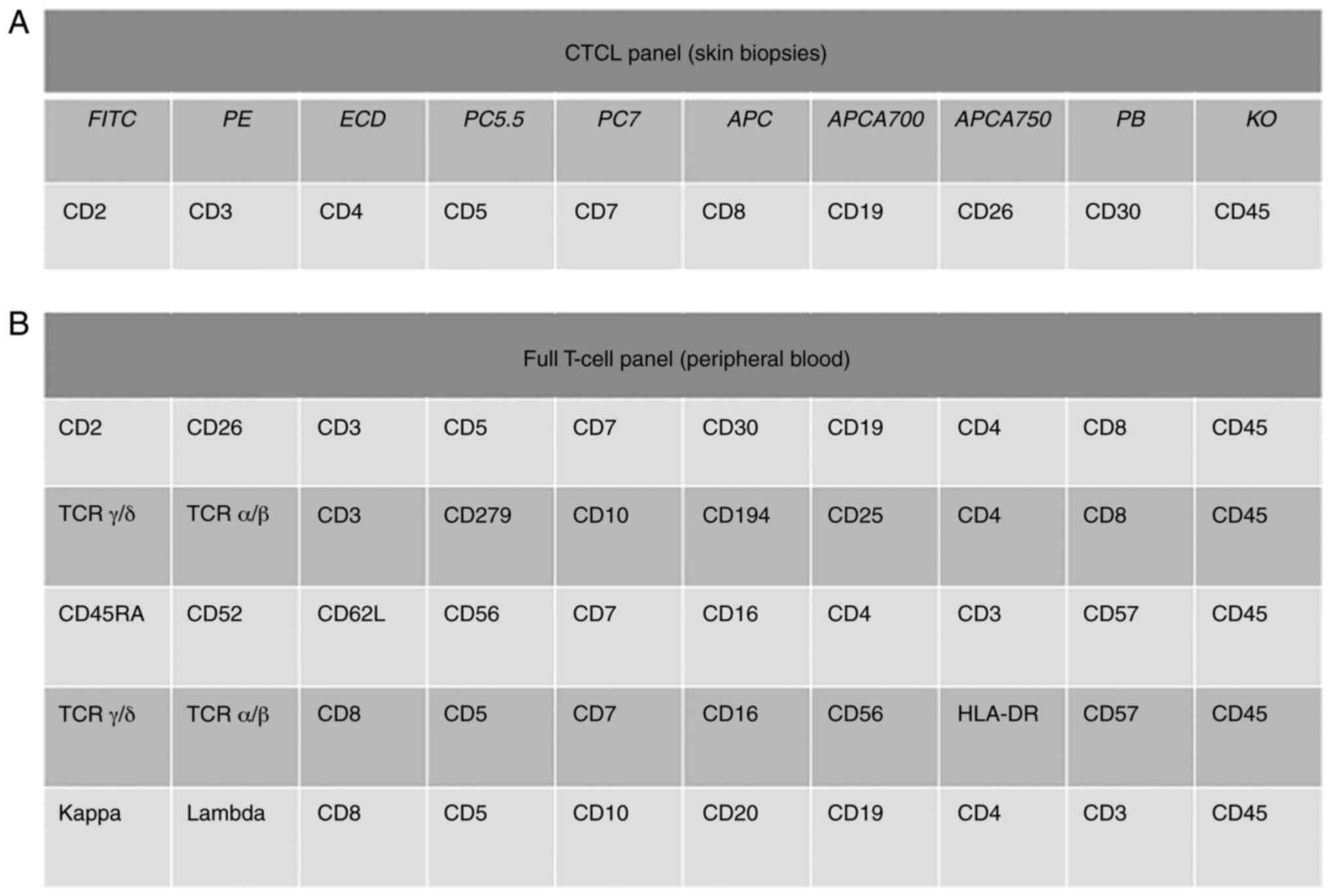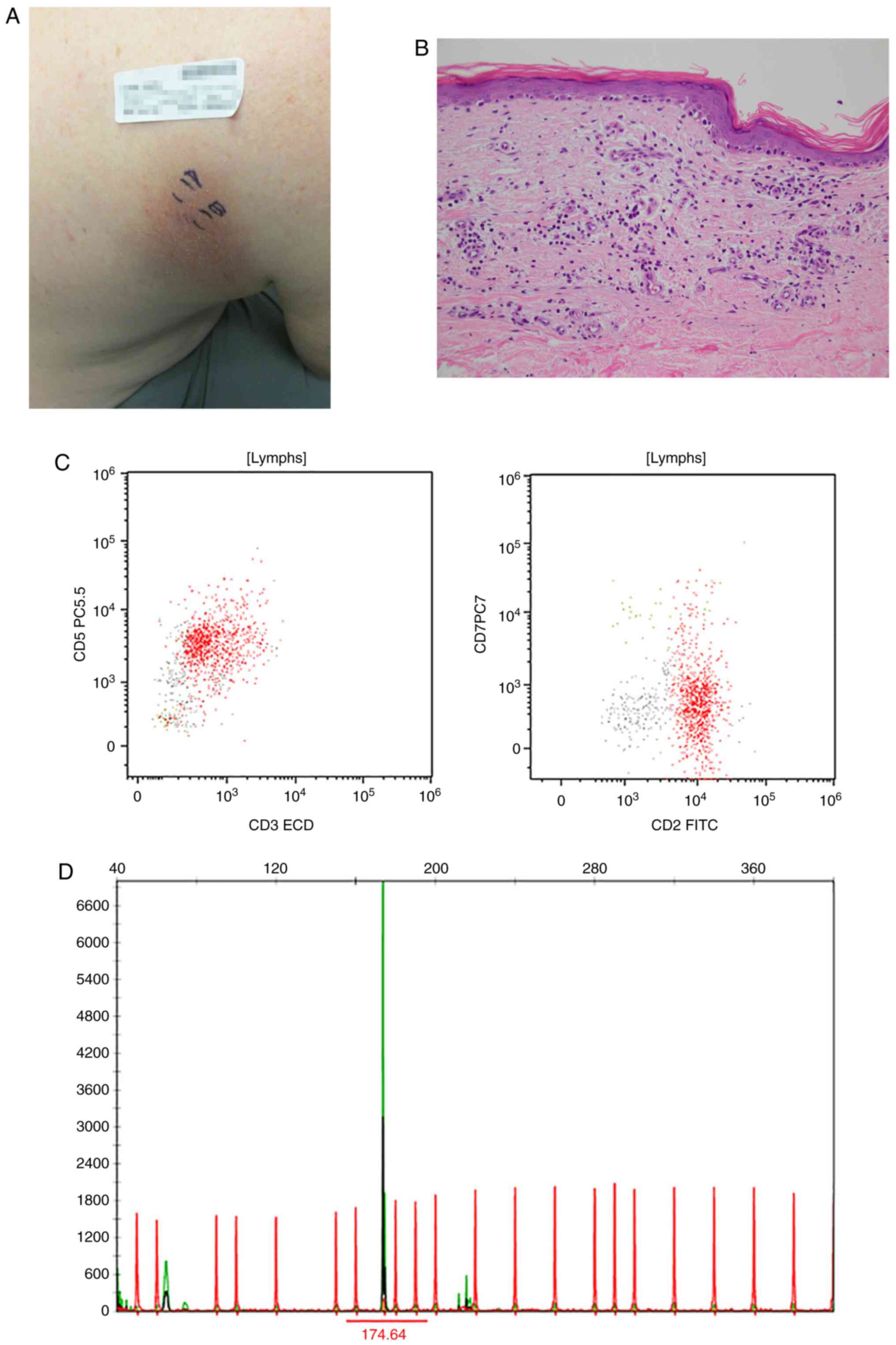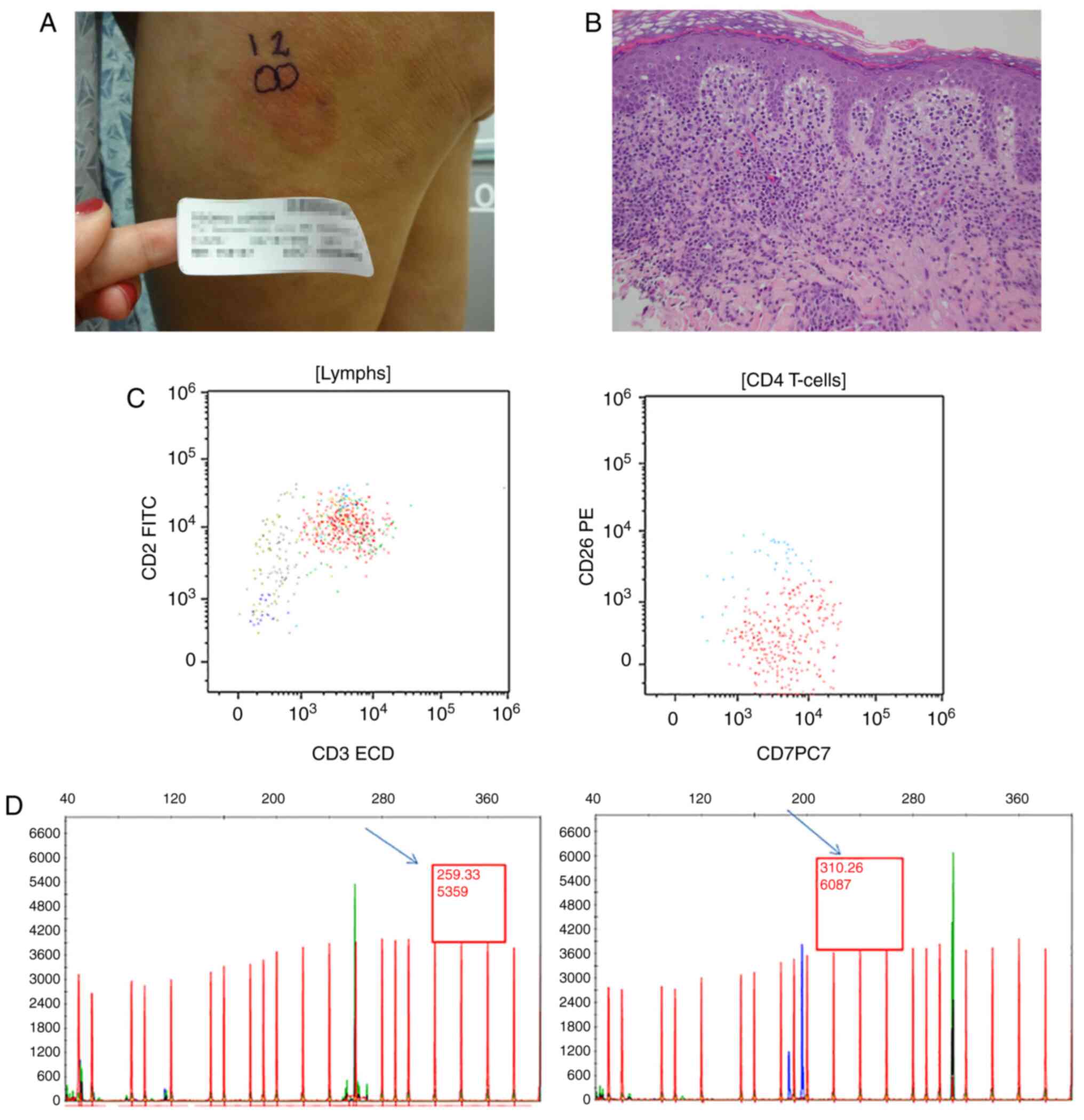|
1
|
Swerdlow SH, Campo E, Harris NL, Jaffe ES,
Pileri SA, Stein H and Thiele J: World Health Organization
Classification of Tumours of Hematopoietic and Lymphoid Tissue.
IARC Press; Lyon: 2008
|
|
2
|
Cerroni L: Lymphoproliferative lesions of
the skin. J Clin Pathol. 59:813–826. 2006. View Article : Google Scholar
|
|
3
|
Willemze R and Meijer CJ: Classification
of cutaneous T-cell lymphoma: From Alibert to WHO-EORTC. J Cutan
Pathol. 33 (Suppl 1):18–26. 2006. View Article : Google Scholar
|
|
4
|
Olsen EA: Evaluation, diagnosis, and
staging of cutaneous lymphoma. Dermatol Clin. 33:643–654. 2015.
View Article : Google Scholar
|
|
5
|
Algara P, Soria C, Martinez P, Sanchez L,
Villuendas R, Garcia P, Lopez C, Orradre JL and Piris MA: Value of
PCR detection of TCR gamma gene rearrangement in the diagnosis of
cutaneous lymphocytic infiltrates. Diagn Mol Pathol. 3:275–282.
1994. View Article : Google Scholar
|
|
6
|
Galper SL, Smith BD and Wilson LD: Wilson,
Diagnosis and management of mycosis fungoides. Oncology (Williston
Park). 24:491–501. 2010.
|
|
7
|
Willemze R, Jaffe ES, Burg G, Cerroni L,
Berti E, Swerdlow SH, Ralfkiaer E, Chimenti S, Diaz-Perez JL,
Duncan LM, et al: WHO-EORTC classification for cutaneous lymphomas.
Blood. 105:3768–3785. 2005. View Article : Google Scholar
|
|
8
|
Cerroni L: Mycosis fungoides-clinical and
histopathologic features, differential diagnosis, and treatment.
Semin Cutan Med Surg. 37:2–10. 2018. View Article : Google Scholar
|
|
9
|
Jawed SI, Myskowski PL, Horwitz S,
Moskowitz A and Querfeld C: Primary cutaneous T-cell lymphoma
(mycosis fungoides and Sézary syndrome): Part I. Diagnosis:
Clinical and histopathologic features and new molecular and
biologic markers. J Am Acad Dermatol. 70:205.e1–16; quiz 221-222.
2014. View Article : Google Scholar
|
|
10
|
Kempf W and Mitteldorf C: Mitteldorf,
pathologic diagnosis of cutaneous lymphomas. Dermatol Clin.
33:655–681. 2015. View Article : Google Scholar
|
|
11
|
Hodak E and Amitay-Laish I: Amitay-Laish,
Mycosis fungoides: A great imitator. Clin Dermatol. 37:255–267.
2019. View Article : Google Scholar
|
|
12
|
Campbell SM, Peters SB, Zirwas MJ and Wong
HK: Immunophenotypic diagnosis of primary cutaneous lymphomas: A
review for the practicing dermatologist. J Clin Aesthet Dermatol.
3:21–25. 2010.
|
|
13
|
Ashton-Key M, Diss TC, Du MQ, Kirkham N,
Wotherspoon A and Isaacson PG: The value of the polymerase chain
reaction in the diagnosis of cutaneous T-cell infiltrates. Am J
Surg Pathol. 21:743–747. 1997. View Article : Google Scholar
|
|
14
|
Alaibac M, Pigozzi B, Belloni-Fortina A,
Michelotto A, Saponeri A and Peserico A: CD7 expression in reactive
and malignant human skin T-lymphocytes. Anticancer Res.
23:2707–2710. 2003.
|
|
15
|
Moll M, Reinhold U, Kukel S, Abken H,
Müller R, Oltermann I and Kreysel HW: CD7-negative helper T cells
accumulate in inflammatory skin lesions. J Invest Dermatol.
102:328–332. 1994. View Article : Google Scholar
|
|
16
|
Lu C, Zhang J, Nagahawatte P, Easton J,
Lee S, Liu Z, Ding L, Wyczalkowski MA, Valentine M, Navid F, et al:
The genomic landscape of childhood and adolescent melanoma. J
Invest Dermatol. 135:816–823. 2015. View Article : Google Scholar
|
|
17
|
Skov AG and Gniadecki R: Gniadecki, Delay
in the histopathologic diagnosis of mycosis fungoides. Acta Derm
Venereol. 95:472–475. 2015. View Article : Google Scholar
|
|
18
|
van Doorn R, Van Haselen CW, van Voorst
Vader PC, Geerts ML, Heule F, de Rie M, Steijlen PM, Dekker SK, van
Vloten WA and Willemze R: Mycosis fungoides: Disease evolution and
prognosis of 309 Dutch patients. Arch Dermatol. 136:504–510. 2000.
View Article : Google Scholar
|
|
19
|
Kirsch IR, Watanabe R, O'Malley JT,
Williamson DW, Scott LL, Elco CP, Teague JE, Gehad A, Lowry EL,
LeBoeuf NR, et al: TCR sequencing facilitates diagnosis and
identifies mature T cells as the cell of origin in CTCL. Sci Transl
Med. 7:308ra1582015. View Article : Google Scholar
|
|
20
|
Maitre E, Le-Page AL, Comoz F, Truquet F,
Damaj G, Cornet E, Verneuil L, Salaün V and Troussard X: Usefulness
of flow cytometry for the detection of cutaneous localization in
malignant hematologic disorders. Cytometry B Clin Cytom.
96:283–293. 2019. View Article : Google Scholar
|
|
21
|
Bawazir MA, Almohideb M, Walsh S, Shear NH
and Alhusayen R: Early-stage mycosis fungoides screening
investigations: A retrospective analysis of 440 cases. J Eur Acad
Dermatol Venereol. 32:e217–e218. 2018. View Article : Google Scholar
|
|
22
|
Horna P, Kurant D, Sokol L, Sotomayor EM,
Moscinski L and Glass LF: Flow cytometric identification of
immunophenotypically aberrant T-cell clusters on skin shave biopsy
specimens from patients with mycosis fungoides. Am J Clin Pathol.
143:785–796. 2015. View Article : Google Scholar
|
|
23
|
Rea B, Haun P, Emerson R, Vignali M,
Farooqi M, Samimi S, Elenitsas R, Kirsch I and Bagg A: Role of
high-throughput sequencing in the diagnosis of cutaneous T-cell
lymphoma. J Clin Pathol. 71:814–820. 2018. View Article : Google Scholar
|
|
24
|
de Masson A, O'Malley JT, Elco CP, Garcia
SS, Divito SJ, Lowry EL, Tawa M, Fisher DC, Devlin PM and Teague
JE: High-throughput sequencing of the T cell receptor β gene
identifies aggressive early-stage mycosis fungoides. Sci Transl
Med. 10:eaar58942018. View Article : Google Scholar
|
|
25
|
Weng WK, Armstrong R, Arai S, Desmarais C,
Hoppe R and Kim YH: Minimal residual disease monitoring with
high-throughput sequencing of T cell receptors in cutaneous T cell
lymphoma. Sci Transl Med. 5:214ra1712013. View Article : Google Scholar
|
|
26
|
Torres-Cabala CA: Diagnosis of T-cell
lymphoid proliferations of the skin: Putting all the pieces
together. Mod Pathol. 33 (Suppl 1):83–95. 2019. View Article : Google Scholar
|
|
27
|
Cocks M, Porcu P, Wick MR and Gru AA:
Recent advances in cutaneous T-cell lymphoma: Diagnostic and
prognostic considerations. Surg Pathol Clin. 12:783–803. 2019.
View Article : Google Scholar
|
|
28
|
Liebmann RD, Anderson B, McCarthy KP and
Chow JW: The polymerase chain reaction in the diagnosis of early
mycosis fungoides. J Pathol. 182:282–287. 1997. View Article : Google Scholar
|
|
29
|
Theodorou I, Delfau-Larue MH, Bigorgne C,
Lahet C, Cochet G, Bagot M, Wechsler J and Farcet JP: Cutaneous
T-cell infiltrates: Analysis of T-cell receptor gamma gene
rearrangement by polymerase chain reaction and denaturing gradient
gel electrophoresis. Blood. 86:305–310. 1995. View Article : Google Scholar
|
|
30
|
Wood GS, Tung RM, Haeffner AC, Crooks CF,
Liao S, Orozco R, Veelken H, Kadin ME, Koh H, Heald P, et al:
Detection of clonal T-cell receptor gamma gene rearrangements in
early mycosis fungoides/Sezary syndrome by polymerase chain
reaction and denaturing gradient gel electrophoresis (PCR/DGGE). J
Invest Dermatol. 103:34–41. 1994. View Article : Google Scholar
|
|
31
|
Zelenetz AD: Guidelines for NHL: Updates
to the management of diffuse large B-cell lymphoma and new
guidelines for primary cutaneous CD30+ T-cell
lymphoproliferative disorders and T-cell large granular lymphocytic
leukemia. J Natl Compr Canc Netw. 12 (Suppl 5):797–800. 2014.
View Article : Google Scholar
|
|
32
|
Liu WP, Song YQ, Zheng W, Wang XP, Ding N
and Zhu J: Aggressive behavior and elevated lactate dehydrogenase
at baseline confer inferior prognosis in patients with primary
cutaneous lymphoma. Clin Lymphoma Myeloma Leuk. 13:534–540. 2013.
View Article : Google Scholar
|
|
33
|
Quereux G, Frot AS, Brocard A, Leux C,
Renaut JJ and Dreno B: Routine bone marrow biopsy in the initial
evaluation of primary cutaneous B-cell lymphoma does not appear
justified. Eur J Dermatol. 19:216–220. 2009. View Article : Google Scholar
|

















